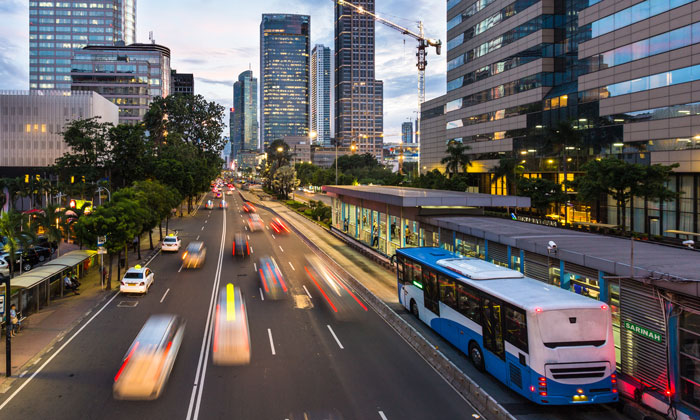Transport for today and tomorrow: the importance of making travel easier
- Like
- Digg
- Del
- Tumblr
- VKontakte
- Buffer
- Love This
- Odnoklassniki
- Meneame
- Blogger
- Amazon
- Yahoo Mail
- Gmail
- AOL
- Newsvine
- HackerNews
- Evernote
- MySpace
- Mail.ru
- Viadeo
- Line
- Comments
- Yummly
- SMS
- Viber
- Telegram
- Subscribe
- Skype
- Facebook Messenger
- Kakao
- LiveJournal
- Yammer
- Edgar
- Fintel
- Mix
- Instapaper
- Copy Link
Posted: 11 April 2018 | Josef Salpeter - FARA | 1 comment
Josef Salpeter, VP Business Development, FARA AS, explains why forward-thinking transport solutions need to affect the public transport of today, not just tomorrow, and why it’s so crucial that operators, authorities and technology providers find a way to put sustainable, efficient transport front and centre to meet passenger requirements…


An increasing part of the population live in cities and urban areas. In fact, 80 per cent of the world’s future population of 9 billion is expected to live in urban areas by 2050. Transportation has already caused most large cities to be heavily congested and polluted. Some front runners have set ambitious goals for city centres to become virtually car-free, like Oslo and Madrid, but that is not reality for the majority and even the capitals of Norway and Spain still have quite a way to go.
Wherever people live, the accessibility and ease of going from A to B has a significant impact on people’s quality of life. The UN Sustainable Development Goals have highlighted the need for sustainable public transport in target 11.2: “By 2030, provide access to safe, affordable, accessible and sustainable transport systems for all.”
Public transport is an essential part of tackling both pollution and congestion, and travelling by public transport needs to be an easy choice.
From here to Hyperloop
Technology has changed access to information drastically and widened the opportunities of what is possible. With smartphones, people have access to information instantly, as well as the possibility to share information instantly themselves. This connection, made possible via the internet, has made way for the sharing economy. Concepts like carpooling/car-sharing (as well as companies like Uber) are examples of exploiting technology to leverage spare capacity of cars. It is, however, not nearly enough to meet the transportation demand of tomorrow. On the other end of the scale there are super innovative solutions such as the Virgin Hyperloop.
Hyperloop could revolutionise current means of transport. However, we are not quite there yet and in the meantime, our public transport system has not changed much in the last few decades: there is a lot that can be done today to make travel easier.
The car revolutionised our means of transport a century ago and now we are talking about another revolution with new technology like Hyperloop, but there is a large gap between where we are and where we want to go. The growing urban population will inevitably increase traffic congestion. And with cities being responsible for 75 per cent of global CO2 emissions, this creates a great need to expand public transportation systems to ensure sustainable mobility.
Prioritising the passenger
We need more people to choose public transportation. Leveraging advanced technology in public transport is a game changer that could make it people’s preferred form of travel. This technology is available today, but the solutions are often fragmented and not powerful enough for people to take the first step away from the comfort and certainty of the private car. We believe that passenger empowerment is the future of travel. Accurate real-time information, mobile optimised applications, route planners and electronic ticketing are therefore some of the features that help the traveller. In order to create a more convenient and seamless travel experience, we must put the passengers and their transport needs in the centre of the solutions.
One way of meeting the passengers’ expectations is by offering one ecosystem that combines the travellers needs for planning their route, easily buying the needed ticket for the trip and getting relevant real-time information throughout the journey. Mobile ticketing is a light replacement to cash and card centric solutions that enables integrating these solutions for the whole trip in one app. Møre og Romsdal, a Norwegian county, was the first county in the Nordics to provide such an ecosystem to its travellers in the form of an app combining travel planning, real-time information and ticketing in one single solution. The technologies of this solution are not new, but combining them with the traveller in mind enables new travellers to move towards using public transport by easy installation of an app. The app provides a very short learning curve and answers all the travellers’ needs before, during and after the trip to ensure that they will choose public transport again.
The current hardware solutions on the bus are also a challenge as they cannot seem to keep up with technology. The solution to this is adding new sensors to support new services such as mobile ticketing validation, unattended ticketing, real-time push information and seamless ticketing through ‘Be-in Be-out’. These don’t have to be expensive solutions but can rely on modern light validators that provide an affordable solution, either standalone or as part of the legacy systems supporting the current smartcard solutions. Availability of such sensors (Bluetooth, Wi-Fi, Barcode reader, NFC) on public transport vehicles can pave the way to new passenger-centric solutions that are currently blocked due to legacy hardware. Again, the technology is available today, but an affordable hardware unit is needed to enable and roll out this big change in public transport solutions to the passengers.
Looking to Oulu
Choosing to travel by public transport requires a certain amount of reliability. A certainty that the bus or train will show up and that it will be on schedule. In Oulu, one of the most populous and technological advanced cities in Finland, the municipality decided to improve the service to its travellers by providing reliable real-time information through an HTML5 site showing live locations of buses on a map. The map is available via the travellers mobile or via large screens installed on main bus stops. This provides passengers with accurate real-time information on departures and arrivals at all times. In addition, a traffic light priority solution ensures buses stay on schedule; helping drivers save up to four minutes on a 15-minute journey. This very affordable traveller-centric solution from the Oulu municipality already has proven itself, while the number of passengers using public transport in Oulu showed a declining trend from 2002 until 2014, Oulu registered a 13.6 per cent increase in the number of public transport passengers within the first year after this solution was introduced.
Encouraged by the success of the above, Oulu has now initiated a pilot project for on-board information and passenger counting on local city buses, using wireless interfaces and only little additional hardware. This is a cost-effective way to further improve the travellers’ experience, providing screens that show the passengers targeted information based on the destination and bus location. This can include estimated arrival and transfer time at the various journey points, flight and train departures when on route to the airport or train station, exact location of the bus on a live map, recent news stories and local updates such as events and happenings. This solution also provides important statistics to improve the public transport planning and utilisation through real-time passenger load profile of the bus to the control centre. Hopefully these traveller-oriented developments utilising cost effective solutions based on available technology will encourage even more travellers in Oulu to choose public transport.
Ready for the future
If we want to meet future transport demands while also taking care of our urban environment, we need to provide our travellers with solutions that make traveling easy, using available technologies applied with the traveller in mind. For cities to become greener we need more people to choose public transport. And for more people to choose public transport, we need to make travel easy.
We are today hampered by legacy solutions on the vehicles and fragmented solutions that make it hard to start using public transport. It is important to look forward for the innovative solutions of tomorrow, be them Hyperloop, autonomous vehicles or others. But we must invest in better solutions for the traveller, applying existing technologies in more integrated and passenger-centric solutions, influencing the customer experience and ensuring more travellers will choose the public transport system we have in place.
Public transportation, with all it entails, is the driving force towards a sustainable future and it all starts now.
Biography


Related topics
Passenger Experience, Sustainable Urban Transport
Related organisations
FARA AS
Related people
Josef Salpeter








Great article! It’s true: we need to make people aware of the air pollution issue! Using greener means of transport we can reduce pollution in our cities.